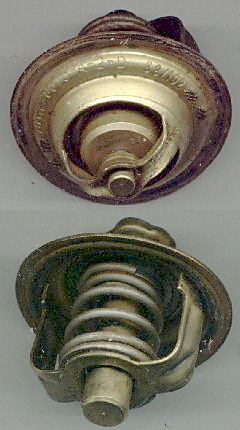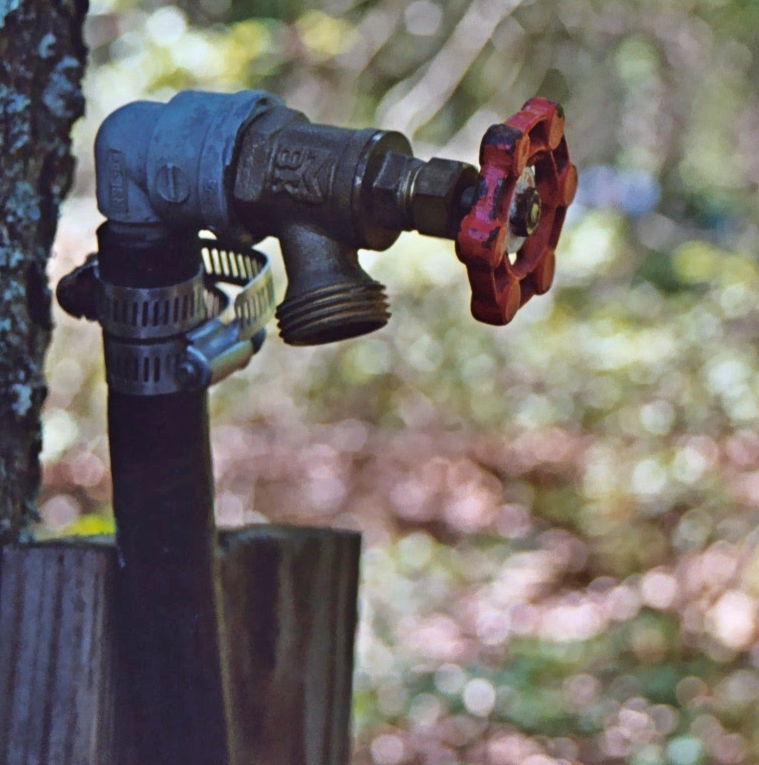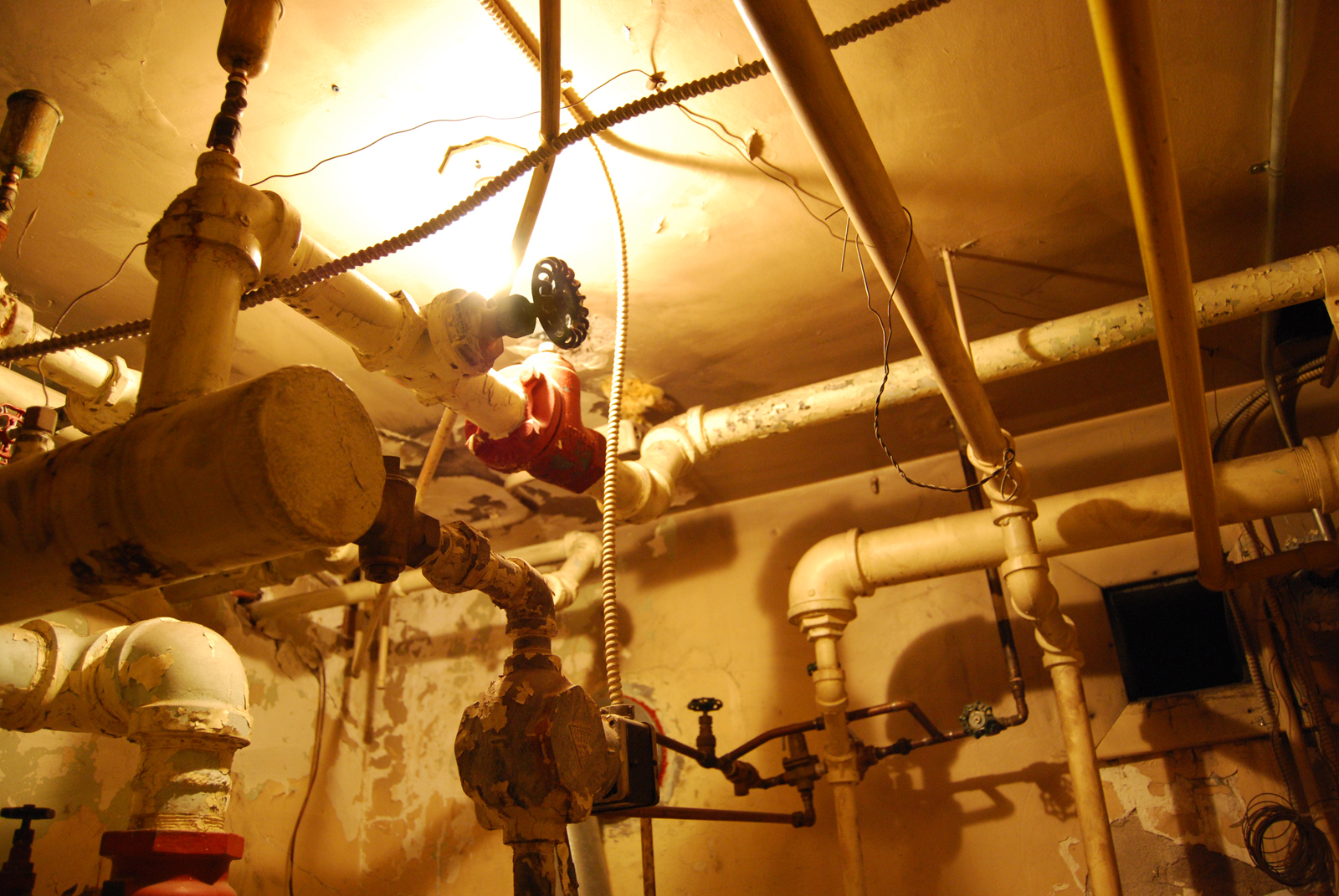|
Mixing Valve
A thermostatic mixing valve (TMV) is a valve that blends hot water with cold water to ensure constant, safe shower and bath outlet temperatures, preventing scalding. The storage of water at high temperature removes one possible breeding ground for Legionella; the use of a thermostat, rather than a static mixing valve, provides increased safety against scalding, and increased user comfort, because the hot-water temperature remains constant. Many TMVs use a wax thermostat for regulation. They also shut off rapidly in the event of a hot or cold supply failure to prevent scalding or thermal shock. It is increasingly common practice around the world to regulate the storage water temperature to above , and to circulate or distribute water at a temperature less than . Water above these temperatures can cause scald injuries. Many countries, states, or municipalities now require that the temperature of all bath water in newly built and extensively refurbished domestic properties be ... [...More Info...] [...Related Items...] OR: [Wikipedia] [Google] [Baidu] |
Valve
A valve is a device or natural object that regulates, directs or controls the flow of a fluid (gases, liquids, fluidized solids, or slurries) by opening, closing, or partially obstructing various passageways. Valves are technically fittings, but are usually discussed as a separate category. In an open valve, fluid flows in a direction from higher pressure to lower pressure. The word is derived from the Latin ''valva'', the moving part of a door, in turn from ''volvere'', to turn, roll. The simplest, and very ancient, valve is simply a freely hinged flap which swings down to obstruct fluid (gas or liquid) flow in one direction, but is pushed up by the flow itself when the flow is moving in the opposite direction. This is called a check valve, as it prevents or "checks" the flow in one direction. Modern control valves may regulate pressure or flow downstream and operate on sophisticated automation systems. Valves have many uses, including controlling water for irrigation, ... [...More Info...] [...Related Items...] OR: [Wikipedia] [Google] [Baidu] |
Burn
A burn is an injury to skin, or other tissues, caused by heat, cold, electricity, chemicals, friction, or ultraviolet radiation (like sunburn). Most burns are due to heat from hot liquids (called scalding), solids, or fire. Burns occur mainly in the home or the workplace. In the home, risks are associated with domestic kitchens, including stoves, flames, and hot liquids. In the workplace, risks are associated with fire and chemical and electric burns. Alcoholism and smoking are other risk factors. Burns can also occur as a result of self-harm or violence between people (assault). Burns that affect only the superficial skin layers are known as superficial or first-degree burns. They appear red without blisters and pain typically lasts around three days. When the injury extends into some of the underlying skin layer, it is a partial-thickness or second-degree burn. Blisters are frequently present and they are often very painful. Healing can require up to eight weeks and scarri ... [...More Info...] [...Related Items...] OR: [Wikipedia] [Google] [Baidu] |
Legionella
''Legionella'' is a genus of pathogenic gram-negative bacteria that includes the species '' L. pneumophila'', causing legionellosis (all illnesses caused by ''Legionella'') including a pneumonia-type illness called Legionnaires' disease and a mild flu-like illness called Pontiac fever. ''Legionella'' may be visualized with a silver stain or cultured in cysteine-containing media such as buffered charcoal yeast extract agar. It is common in many environments, including soil and aquatic systems, with at least 50 species and 70 serogroups identified. These bacteria, however, are not transmissible from person to person; furthermore, most people exposed to the bacteria do not become ill. Most outbreaks are traced to poorly maintained cooling towers. The side chains of the cell wall carry the bases responsible for the somatic antigen specificity of these organisms. The chemical composition of these side chains both with respect to components and arrangement of the different sugars de ... [...More Info...] [...Related Items...] OR: [Wikipedia] [Google] [Baidu] |
Thermostat
A thermostat is a regulating device component which senses the temperature of a physical system and performs actions so that the system's temperature is maintained near a desired setpoint. Thermostats are used in any device or system that heats or cools to a setpoint temperature. Examples include building heating, central heating, air conditioners, HVAC systems, water heaters, as well as kitchen equipment including ovens and refrigerators and medical and scientific incubators. In scientific literature, these devices are often broadly classified as thermostatically controlled loads (TCLs). Thermostatically controlled loads comprise roughly 50% of the overall electricity demand in the United States. A thermostat operates as a "closed loop" control device, as it seeks to reduce the error between the desired and measured temperatures. Sometimes a thermostat combines both the sensing and control action elements of a controlled system, such as in an automotive thermostat. T ... [...More Info...] [...Related Items...] OR: [Wikipedia] [Google] [Baidu] |
Wax Thermostatic Element
The wax thermostatic element was invented in 1934 by Sergius Vernet (1899–1968). Its principal application is in automotive thermostats used in the engine cooling system. The first applications in the plumbing and HVAC, heating industries were in Sweden (1970) and in Switzerland (1971). Wax thermostatic elements transform heat energy into mechanical energy using the thermal expansion of waxes when they melt. This wax motor principle also finds applications besides engine cooling systems, including heating system thermostatic radiator valves, plumbing, industrial, and agriculture. Automotive thermostats The internal combustion engine cooling thermostat maintains the temperature of the engine near its optimum operating temperature by regulating the flow of coolant to an air cooled radiator (engine cooling), radiator. This regulation is now carried out by an internal thermostat. Conveniently, both the sensing element of the thermostat and its control valve may be placed at the same ... [...More Info...] [...Related Items...] OR: [Wikipedia] [Google] [Baidu] |
Central Heating
A central heating system provides warmth to a number of spaces within a building from one main source of heat. It is a component of heating, ventilation, and air conditioning (short: HVAC) systems, which can both cool and warm interior spaces. A central heating system has a furnace that converts fuel or electricity to heat. The heat is circulated through the building either by fans forcing heated air through ducts, circulation of low-pressure steam to radiators in each heated room, or pumps that circulate hot water through room radiators. Primary energy sources may be fuels like coal or wood, oil, kerosene, natural gas, or electricity. Compared with systems such as fireplaces and wood stoves, a central heating plant offers improved uniformity of temperature control over a building, usually including automatic control of the furnace. Large homes or buildings may be divided into individually controllable zones with their own temperature controls. Automatic fuel (and sometimes ash ... [...More Info...] [...Related Items...] OR: [Wikipedia] [Google] [Baidu] |
Tap (valve)
A tap (also spigot or faucet: see usage variations) is a valve controlling the release of a liquid or gas. Nomenclature United Kingdom * Tap is used in the United Kingdom and most of the Commonwealth for any everyday type of valve, particularly the fittings that control water supply to bathtubs and sinks. United States * Faucet is the most common term in the US, similar in use to "tap" in British English, e.g. "water faucet" (although the term "tap" is also used in the US). * Spigot is used by professionals in the trade (such as plumbers), and typically refers to an outdoor fixture. * Silcock (and sillcock), same as "spigot", referring to a "cock" (as in stopcock and petcock) that penetrates a foundation sill. * Bib (bibcock, and hose bib or hosebibb), usually a freeze-resistant version of a "spigot". * Wall hydrant, same as "hosebibb". * Tap generally refers to a keg or barrel tap, though also commonly refers to a faucet that supplies either hot or cold water and not ... [...More Info...] [...Related Items...] OR: [Wikipedia] [Google] [Baidu] |
Thermostatic Radiator Valve
A thermostatic radiator valve (TRV) is a self-regulating valve fitted to hot water heating system radiator, to control the temperature of a room by changing the flow of hot water to the radiator. Functioning Conventional wax motor TRV The classic thermostatic radiator valve contains a plug, typically made of wax (forming a wax motor), which expands or contracts with the surrounding temperature. This plug is connected to a pin which in turn is connected to a valve. The valve gradually closes as the temperature of the surrounding area increases, limiting the amount of hot water entering the radiator. This allows a maximum temperature to be set for each room. As the valve works by sensing the temperature of the air surrounding it, it is important to ensure that it is not covered by material (such as curtains). If the controller is removed from the valve, the valve turns on and the radiator will always be hot. Interaction with room thermostats Thermostatic radiator valve sho ... [...More Info...] [...Related Items...] OR: [Wikipedia] [Google] [Baidu] |
Pressure-balanced Valve
A pressure-balanced valve provides water at nearly constant temperature to a shower or bathtub, despite pressure fluctuations in either the hot or cold supply lines. If, for example, someone flushes a toilet while the shower is in use, the fixture suddenly draws a significant amount of cold water from the common supply line, causing a pressure drop. In the absence of a compensating mechanism, the relatively higher pressure in the hot water supply line will cause the shower temperature to rise just as suddenly, possibly reaching an uncomfortable or even dangerous level. Conversely, if someone opens a hot water faucet elsewhere, the relatively higher pressure in the cold water supply line will cause the shower temperature to drop suddenly. This is described in US patent 3674048. The pressure-balanced shower valve compensates for changes in water pressure. It has a diaphragm or piston inside that reacts to relative changes in either hot or cold water pressure to maintain balanced p ... [...More Info...] [...Related Items...] OR: [Wikipedia] [Google] [Baidu] |
Plumbing
Plumbing is any system that conveys fluids for a wide range of applications. Plumbing uses pipes, valves, plumbing fixtures, tanks, and other apparatuses to convey fluids. Heating and cooling (HVAC), waste removal, and potable water delivery are among the most common uses for plumbing, but it is not limited to these applications. The word derives from the Latin for lead, ''plumbum'', as the first effective pipes used in the Roman era were lead pipes. In the developed world, plumbing infrastructure is critical to public health and sanitation. Boilermakers and pipefitters are not plumbers although they work with piping as part of their trade and their work can include some plumbing. History Plumbing originated during ancient civilizations, as they developed public baths and needed to provide potable water and wastewater removal for larger numbers of people. The Mesopotamians introduced the world to clay sewer pipes around 4000 BCE, with the earliest examples found i ... [...More Info...] [...Related Items...] OR: [Wikipedia] [Google] [Baidu] |







